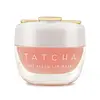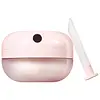What's inside
What's inside
 Key Ingredients
Key Ingredients

 Benefits
Benefits

 Concerns
Concerns

 Ingredients Side-by-side
Ingredients Side-by-side

Triisostearin
Skin ConditioningPolyglyceryl-2 Triisostearate
EmulsifyingSqualane
EmollientDextrin Palmitate
EmulsifyingVp/Hexadecene Copolymer
Silica
AbrasiveDextrin Palmitate/Ethylhexanoate
EmulsifyingCamellia Japonica Seed Oil
EmollientPrunus Persica Kernel Extract
MoisturisingPrunus Persica Juice
MoisturisingPrunus Persica Leaf Extract
EmollientCitrus Unshiu Peel Extract
MaskingSaccharomyces/Rice Ferment Filtrate
Skin ConditioningCamellia Sinensis Leaf Extract
AntimicrobialCladosiphon Okamuranus Extract
Skin ConditioningAllantoin
Skin ConditioningStearyl Glycyrrhetinate
Skin ConditioningTocopherol
AntioxidantPyridoxine Hcl
Skin ConditioningWater
Skin ConditioningPropanediol
SolventButylene Glycol
HumectantEthylhexylglycerin
Skin ConditioningParfum
MaskingPhenoxyethanol
PreservativeLimonene
PerfumingLinalool
PerfumingCI 77491
Cosmetic ColorantTriisostearin, Polyglyceryl-2 Triisostearate, Squalane, Dextrin Palmitate, Vp/Hexadecene Copolymer, Silica, Dextrin Palmitate/Ethylhexanoate, Camellia Japonica Seed Oil, Prunus Persica Kernel Extract, Prunus Persica Juice, Prunus Persica Leaf Extract, Citrus Unshiu Peel Extract, Saccharomyces/Rice Ferment Filtrate, Camellia Sinensis Leaf Extract, Cladosiphon Okamuranus Extract, Allantoin, Stearyl Glycyrrhetinate, Tocopherol, Pyridoxine Hcl, Water, Propanediol, Butylene Glycol, Ethylhexylglycerin, Parfum, Phenoxyethanol, Limonene, Linalool, CI 77491
Diisostearyl Malate
EmollientHydrogenated Polyisobutene
EmollientPhytosteryl/Isostearyl/Cetyl/Stearyl/Behenyl Dimer Dilinoleate
Skin ConditioningPolybutene
Hydrogenated Poly(C6-14 Olefin)
EmollientButyrospermum Parkii Butter
Skin ConditioningMicrocrystalline Wax
Emulsion StabilisingSynthetic Wax
AbrasiveEthylene/Propylene/Styrene Copolymer
Sucrose Tetrastearate Triacetate
EmollientMica
Cosmetic ColorantCI 77891
Cosmetic ColorantEuphorbia Cerifera Wax
Ethylhexyl Palmitate
EmollientParfum
MaskingCandelilla Wax Esters
Astrocaryum Murumuru Seed Butter
EmollientTribehenin
EmollientMenthoxypropanediol
MaskingGlycerin
HumectantCocos Nucifera Oil
MaskingOenothera Biennis Oil
EmollientLecithin
EmollientButylene/Ethylene/Styrene Copolymer
Sorbitan Isostearate
EmulsifyingCopernicia Cerifera Wax
Dehydroacetic Acid
PreservativeAdenosine
Skin ConditioningTocopherol
AntioxidantLactic Acid
BufferingPentaerythrityl Tetra-Di-T-Butyl Hydroxyhydrocinnamate
AntioxidantPalmitoyl Tripeptide-1
Skin ConditioningDiisostearyl Malate, Hydrogenated Polyisobutene, Phytosteryl/Isostearyl/Cetyl/Stearyl/Behenyl Dimer Dilinoleate, Polybutene, Hydrogenated Poly(C6-14 Olefin), Butyrospermum Parkii Butter, Microcrystalline Wax, Synthetic Wax, Ethylene/Propylene/Styrene Copolymer, Sucrose Tetrastearate Triacetate, Mica, CI 77891, Euphorbia Cerifera Wax, Ethylhexyl Palmitate, Parfum, Candelilla Wax Esters, Astrocaryum Murumuru Seed Butter, Tribehenin, Menthoxypropanediol, Glycerin, Cocos Nucifera Oil, Oenothera Biennis Oil, Lecithin, Butylene/Ethylene/Styrene Copolymer, Sorbitan Isostearate, Copernicia Cerifera Wax, Dehydroacetic Acid, Adenosine, Tocopherol, Lactic Acid, Pentaerythrityl Tetra-Di-T-Butyl Hydroxyhydrocinnamate, Palmitoyl Tripeptide-1
 Reviews
Reviews

Ingredients Explained
These ingredients are found in both products.
Ingredients higher up in an ingredient list are typically present in a larger amount.
Parfum is a catch-all term for an ingredient or more that is used to give a scent to products.
Also called "fragrance", this ingredient can be a blend of hundreds of chemicals or plant oils. This means every product with "fragrance" or "parfum" in the ingredients list is a different mixture.
For instance, Habanolide is a proprietary trade name for a specific aroma chemical. When used as a fragrance ingredient in cosmetics, most aroma chemicals fall under the broad labeling category of “FRAGRANCE” or “PARFUM” according to EU and US regulations.
The term 'parfum' or 'fragrance' is not regulated in many countries. In many cases, it is up to the brand to define this term.
For instance, many brands choose to label themselves as "fragrance-free" because they are not using synthetic fragrances. However, their products may still contain ingredients such as essential oils that are considered a fragrance by INCI standards.
One example is Calendula flower extract. Calendula is an essential oil that still imparts a scent or 'fragrance'.
Depending on the blend, the ingredients in the mixture can cause allergies and sensitivities on the skin. Some ingredients that are known EU allergens include linalool and citronellol.
Parfum can also be used to mask or cover an unpleasant scent.
The bottom line is: not all fragrances/parfum/ingredients are created equally. If you are worried about fragrances, we recommend taking a closer look at an ingredient. And of course, we always recommend speaking with a professional.
Learn more about ParfumTocopherol (also known as Vitamin E) is a common antioxidant used to help protect the skin from free-radicals and strengthen the skin barrier. It's also fat soluble - this means our skin is great at absorbing it.
Vitamin E also helps keep your natural skin lipids healthy. Your lipid skin barrier naturally consists of lipids, ceramides, and fatty acids. Vitamin E offers extra protection for your skin’s lipid barrier, keeping your skin healthy and nourished.
Another benefit is a bit of UV protection. Vitamin E helps reduce the damage caused by UVB rays. (It should not replace your sunscreen). Combining it with Vitamin C can decrease sunburned cells and hyperpigmentation after UV exposure.
You might have noticed Vitamin E + C often paired together. This is because it is great at stabilizing Vitamin C. Using the two together helps increase the effectiveness of both ingredients.
There are often claims that Vitamin E can reduce/prevent scarring, but these claims haven't been confirmed by scientific research.
Learn more about Tocopherol